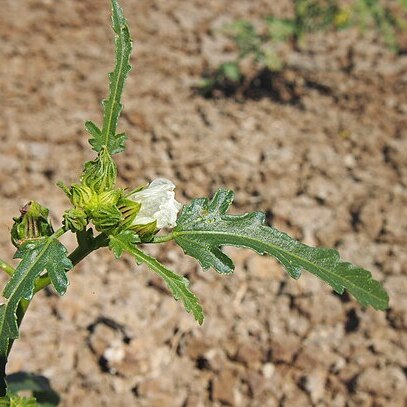Herb, subshrub or shrub 0.1–2.5 (–3) m high. Branchlets indumentum variable, with only glandular hairs, or with stellate hairs, aculei, and glandular hairs, or aculei and glandular hairs, or stellate hairs, fine bristles and glandular hairs, the aculei sparse to moderately dense, 0.4–1 mm long, the fine bristles moderately dense to very dense, the stellate hairs fine, sparse to moderately dense, scattered or in a longitudinal band on each internode, or both. Stipules caducous, subulate to very narrowly triangular, 3–13 mm long, indumentum similar to the branchlets. Climax leaves: petiole 35–80 mm long, indumentum similar or dissimilar to branchlet; lamina orbicular, narrowly ovate, ovate, or narrowly elliptic, unlobed to deeply 1–7-lobed (lobes shorter than wide to longer than wide) 40–150 mm long, 45–180 mm wide, truncate or cordate base, serrate margin, acute to acuminate apex, concolorous or discolourous, the indumentum similar on both surfaces, the abaxial surface indumentum extremely variable with any combination of stellate hairs (scattered to moderately dense, coarse), aculei, fine bristles (sparse to scattered), glandular hairs always present. Distal leaves reduced in shape and size, linear, narrowly elliptic, narrowly ovate or orbicular. Foliar nectary at lamina base, 2–6 mm long. Flowers solitary in leaf axils, usually not pedunculate; peduncle if present not well developed, 1–4 mm long, glabrous or with aculei; pedicel 3–22 mm long, with aculei or glabrous; epicalyx hairy or glabrous, if hairy with with stellate hairs and/or fine bristles, 8–15-segmented, segments free at the base, linear, incurved and recurved, 3-veined, 8–15 mm long; calyx 15–20 (–30) mm long in fruit, indumentum whitish with sparse aculei or fine bristles, calyx nectaries absent; petals 40–65 mm long, white or pink; staminal column 15–21 mm long, stamens distributed along the distal 12–20 mm, filaments 1–1.5 mm long; style extends 0–6 mm beyond apex of staminal column, style branches 1–4 mm long, stigmatic hairs c. 0.5 mm long. Capsule broadly ovoid, 13–19 mm long, glabrous or sparsely hairy, the hairs appressed, the beak 1–3 mm long. Seeds angular-subreniform, c. 4 mm long.
More
An erect annual shrub. It grows 1-2 m high. The stems are hairy. The leaves are coarse and dark green. The size and shape of the leaves varies. The lower leaves can be divided into 3-5 narrow lobes. The leaf blade is 10-18 cm long by 2.5-8.5 cm wide. The flowers are large and white. They have a red centre. They are about 7-10 cm across. Flowers occur singly and in the axils of leaves. The fruit are slightly woody capsules. These are about 1.5-1.7 cm long and 1.5 cm wide. The seeds inside are dark brown and kidney shaped.
Grows in a variety of habitats from coastal vine thickets, riparian vegetation, Melaleuca forests and lowland savanna to sandstone woodlands and shrublands. On a variety of substrates including laterite, sandstone, clay, coastal sands and limestone. (Flora of Darwin Region, Cowie et al. 2013). Alluvium, sandy and clayey soils. Clay flats, floodplains, along creeks, sandstone rocks. (FloraBase) Altitudinal range from near sea level to 900 m. Usually grows in open forest but sometimes found on the margins of monsoon forest and vine thickets. (Rainforest Key, Zich et al. 2020). Commonly associated with creek banks and river edges, but can also be found in drier habitats like grasslands, forests, mountain ranges, and monsoon shrubs. Can also be weedy and occur on roadsides (T. McLay, pers. observ.).
More
It is a tropical plant. Plants grow naturally in open forest often on poor soils. They can be along the banks of rivers.



